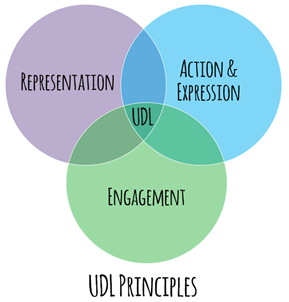Office of the Provost–Division of Faculty Success
Trinity Hall 106, 800 Greek Row Dr., Box 19128
The University of Texas at Arlington
Arlington, TX 76019
Phone: 817-272-7464 | Email: CRTLE@uta.edu
Accessibility and Universal Design for Learning

Recent Highlight - Creating an Accessible Learning Environment for All Students
How should faculty create an equitable and accommodating learning environment for all students? This question, along with many others, were discussed during our session on March 29th. We shared the perspective of students with disabilities on creating a learning environment that promotes a sense of belonging and support their academic success.
Accessibility Resources
- PowerPoint Accessibility Checklist 2022_10
- Word Accessibility Checklist 2022_10
- Accessibility Session 1 - Electronic Accessibility
- Accessibility Session 2 - Accommodating for Students with Low Vision and/or Hard of Hearing
“A universally designed course integrates multiple means of representation (how content is delivered), action and expression (how students demonstrate their knowledge), and engagement (how students participate).”
What is UDL?
- A framework for curriculum design that fosters an inclusive learning environment.
- Minimizing barriers to learning and helping to ensure that all students have an equal opportunity to succeed.
- Providing multiple pathways to achieve course outcomes by motivating and engaging students with different learning styles, needs, and abilities.
- A research-informed approach based on current scientific understanding of how people learn (how to optimize the learning experience by supporting the needs of diverse students)
What are some examples of UDL?
- A composition faculty member began audio taping his class so students could review class discussion and the professor's instructions about completing assignments.
- A foreign language professor used puppet shows, role plays, velcro cards, and searches of computer web sites in the second language to make the instruction as multi-modal as possible.
- A psychology professor allowed students the choice of writing the final exam as a take-home or a 3-hour in-class final.
- A biology professor introduces new topics by asking all students to write a short essay on the topic, in class. Some students are better writers than talkers, and the professor finds that this practice leads to more universal participation in the subsequent class discussions.
- A sociology professor revised her syllabus to specify the objectives more clearly, and added a research project in addition to the midterm and final exam in order to diversify the types of work that affected the final grade in the course.
- A geology professor developed computer animation modules to illustrate some of the key concepts in a course on physical hydrology. These are shown in class and available out of class as well.
- A computer science professor started to begin each class with a forecast of the key concepts to be discussed that day and why they are important in the course material (after students complained that they had no context for his lectures).
- For more information, please refer to Universal Design for Learning: theory and practice
Applying Instructional Techniques of Learning Network
Resources: ADA Compliance Checklists Do's and Don'ts
References:
- https://enact.sonoma.edu/ld.php?content_id=39359412
- https://www.colorado.edu/assett/faculty-resources/services/udl
- http://www.flconsortiumudl.net/content/section4/04.aspx

